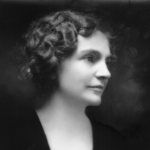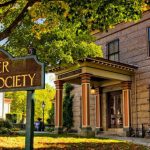The late 19th and early 20th century was the heyday of china painting in America, and during that period countless women took brush in hand and churned out a plethora of ornamental pieces of all sorts—tchotchkes, you might say—and myriad articles of tableware.
In keeping with their sisters across the nation, Fall River women enthusiastically embraced the fad, with numerous extant examples evidencing the various degrees of talent possessed by these mostly amateur artisans.
Some pieces are beautifully painted—remarkably so—while many others, with less artistic merit and the result of a not-so-steady hand, were likely greeted with the maxim: “Isn’t that lovely, dear,” slightly mocking in its utterance.
I have seen heaps of the stuff over the years and, to be perfectly honest, in many case have often wondered what some of the ladies were thinking—but if they were pleased with the end result I suppose that is all that mattered.
Beauty, as they say, is in the eye of the beholder.
Good for them, though perhaps less so for the recipients of some of their artwork.
In Fall River, the most talented china painter of the era was Lillian F. Wilbur (1868-1951), who carved a niche for herself as a professional artist.
Miss Wilbur, as she was widely known, made a successful career pursuing the genteel and “womanly” oeuvre of watercolor and china painting, deemed acceptable for Victorian era ladies, especially so in somewhat provincial—and decidedly prudish—Fall River. Lillian often exhibited alongside the city’s most prominent artists; her still life paintings of fruit and flowers, rendered in watercolor, are exquisite and were widely sought after. Print and photographic evidence confirms that she also worked in oil-on- canvas, but I have not seen an example of her work in that medium.
At least not yet.
Among her output in china painting were extensive sets of tableware—dinner, luncheon, and dessert services—bearing, in elaborate entwined fonts in all manner of styles, the monograms of the daughters of Fall River’s leading families. These were specially commissioned as engagement or wedding gifts, considered de rigueur for the well-appointed home of any well-heeled bride with a staff to maintain them.
Lillian painted crates of the stuff during her career: Believe me, I have been served from it on more than one occasion, usually while being told about “mother’s” wedding china.
Lillian was also an instructor of painting and several Fall River women sought tutelage in her studio. Among them was Harriet Bence Silvia (1878-1971), called Hattie, who was one of her most talented pupils.
But by the time Hattie began her studies with Miss Wilbur—where she mastered the art form—she was already skilled as a china painter, having previously studied with another artist, also noted in Fall River for her work in that medium.
But I am getting ahead of myself.
Suffice it to say that there were no worries if you received a gift of china painted by Hattie.
One likely said “Thank You” —and meant it.
Hattie—a Fall River native—was the daughter of Joseph E. Silvia (1843-1925), and his wife, née Emeline E. Perry (1850-1941), and according to her obituary: ”She was a part of this city’s history, since she was a member of the first Portuguese family to settle in the area.”
Her family had settled here early: Hattie’s mother, Emeline, emigrated from the Azores in 1857 with her mother; her father and other family members had emigrated the previous year. Hattie’s father, Joseph, emigrated to the United States with his parents in 1842—he was just six months old; he settled in Fall River in 1863.
Joseph and Emeline were married in Fall River in 1865; they had ten children.
Joseph was employed as a hairdresser and set up shop upon arrival in Fall River; for many years he was a partner with Manuel X. Dyer (1844-1914), operating as Dyer & Silvia. He retired from active business in 1914, by which time “he was well-known throughout the city and had a great many friends.”
The Silvia family placed a strong emphasis on education. Hattie attended the Fall River public schools and graduated from Durfee High School with the Class of 1897—she maintained a life-long affinity for her alma mater, serving as Class Secretary until her death.
Her class records and scrapbooks were meticulously kept—as one would expect from a maiden lady of the era—and are comprehensive to the extreme; Hattie willed them to the FRHS where she was a member for decades, from the 1920s until her death.
Following Durfee, she entered the Fall River Normal School, graduating in 1899, and thereafter made a life-long career teaching in the public school system in her native city, for many years at the elementary school level. She retired in 1942 as an art teacher at the James Madison Morton Junior High School.
Religion was a mainstay of the Silvia family—they were staunch supporters of the First Baptist Church, with Hattie’s mother a dedicated parishioner, likewise encouraging her children. Hattie taught Sunday school there for decades, taught the Corner Class, and was a member of the Philathea Society. In short: “She loved her church.”
In a very class conscious, prejudicial, and rigid ethnically class-structured Fall River, the Silvia family thrived and achieved socioeconomic success, traveling in a social milieu that was well-educated and middle-class.
A prime example in upward mobility.
Kudos to them.
At the time, the vast majority of Fall River’s Portuguese community—my paternal ancestors among them—were laborers working in the city’s cotton mills, and were not “received” outside their own community.
Times certainly have changed, at least in some aspects.
A good thing, that.
Teaching earned Hattie her living—she was dedicated to her work—but art was her passion.
Hattie possessed a natural talent—at the prompting of her family, she began honing her skills in childhood. Her artistic training commenced at the age of ten; she studied with Miss Harriet Bence (1852-1941), a very close family friend, on a once-weekly basis.
Miss Bence—a native of England brought to Fall River by her family when a child—was a graduate of the Art Department of Boston’s New England Conservatory; working professionally as an artist in her adopted city, she maintained a studio in her family home on Linden Street. In addition, she was an instructor in oil and china painting—specializing in the latter—and much like Lillian F. Wilbur, counted many Fall River women among her students.
Her young student, Hattie, excelled.
So, how close was Harriet Bence and the Silvia family?
Harriet Bence Silvia—our Hattie—was named for Miss Harriet Bence.
They were extremely close, I would say.
As an adult, Hattie studied with aforementioned Miss Wilbur and attended courses at Harvard University and the Rhode Island School of Design; she worked in oil, watercolor, and pastel—her forte, however, was china painting.
And in it, she excelled, producing beautifully rendered pieces, meticulously drawn, on par with her professional contemporaries.
Her output was prolific, and although she was credited in her obituary as a “Noted Artist,” Hattie never aspired to professional status. Still, her work found its way into many local collections and she did exhibit her work publicly.
The appellation, then, was a fitting one.
Well known on the local lecture circuit on the topic of art in various forms, she also wrote on the subject, and was published in area newspapers during the 1920s.
Hattie, it seems, had a good life.
Anyone I knew—now dead —or know—now living—that knew Hattie always spoke/speaks highly of her, and, for that, I took/take them at their word.
No reason not to.
She died in Fall River in 1971, after a brief illness.
Over the subsequent years, a few examples of Hattie’s work made their way into the collection of the FRHS, the gifts of various donors.
But, quite recently, that changed.
The FRHS’s holdings of her work has been enhanced by the donation of four examples painted on china—three pieces dated 1901, and another, done over a half-century later, in 1953; in the last example her hand was no less steady.
And it occurred just by chance, as I was whiling away the waiting time before the FRHS Annual Meeting, held at Adams House on the evening of Wednesday, May 30th, 2018—mentioned by me in a previous post.
I spotted an example of Hattie’s work on display on a hallway étagère … and then another, sitting on the shelf below.
Interesting, that.
Were there others?
A treasure hunt of sorts.
In the parlor—on a built-in shelving unit on the south wall, just to the right of the entrance door—was an additional piece.
And just below, yet another.
The rest, as they say, is history.
The pieces were consequently donated to the FRHS; for that, the Adams House has my very sincere thanks.
So, what are they?
The collection comprises articles of tableware: A tricorne shaped bowl painted with nasturtiums; a handled oval serving platter, decorated with geraniums; a cake plate with a rustic haystack scene bordered in poppies; and a diminutive cream pitcher, with a rose-bud border.
Beautiful examples of her work, they stand as testament to Hattie’s talent as a china painter and are a fine addition to the FRHS’s ever-growing collection of 19thand 20thcentury decorative arts.
I think Hattie would be pleased.
No, let me rephrase that.
I am certain she would be.












